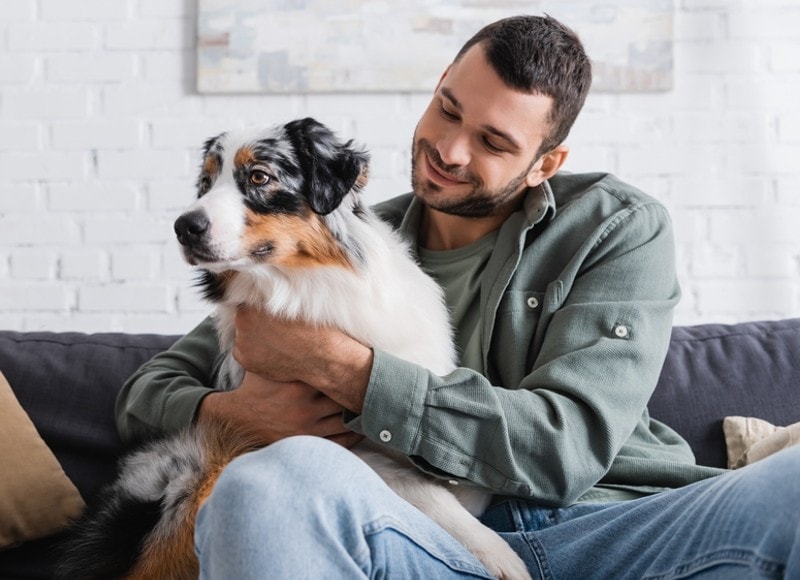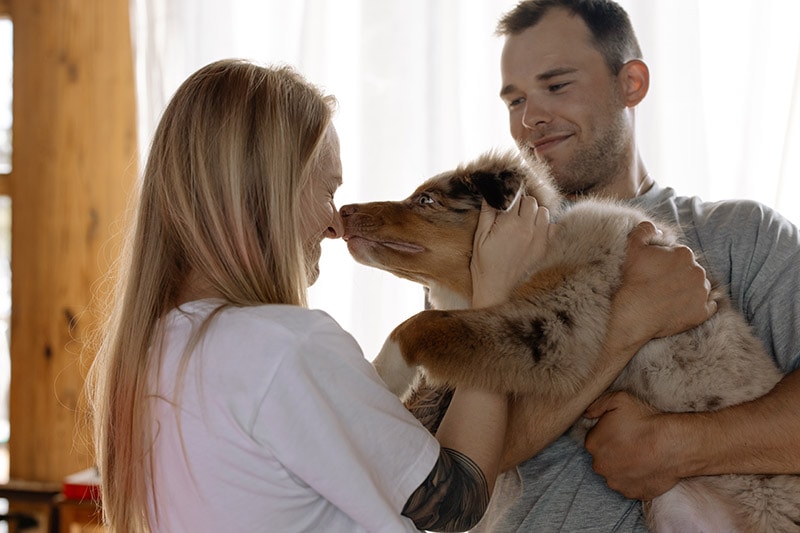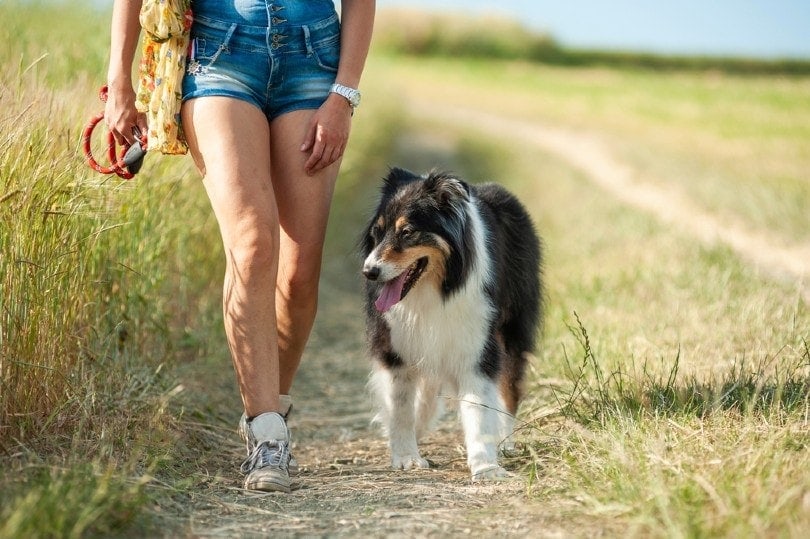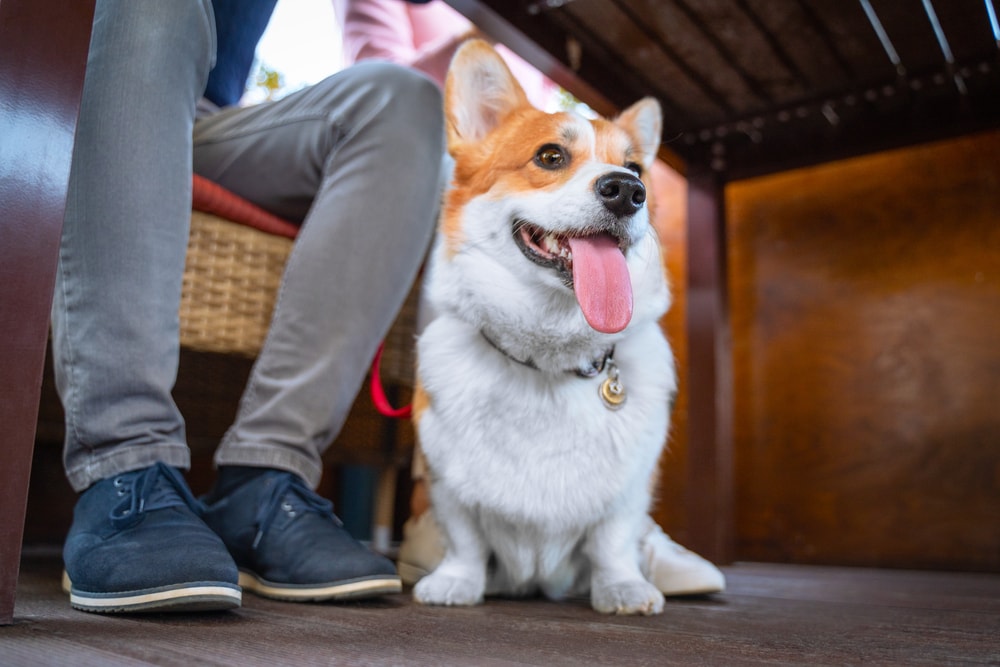Why Does My Australian Shepherd Sit on Me So Often? Top 4 Reasons!
By Jessica Kim
Updated on

Australian Shepherds are loyal dogs that are perfectly content spending their whole day with their favorite humans. If you find that your Australian Shepherd is constantly sitting on you, consider it a compliment. It has bonded to you, and this act is usually a display of affection.
Keep in mind that not all Australian Shepherds will exhibit this behavior, and it doesn’t mean that they don’t like their owners. There can also be other reasons why they might sit on you. We’ll review the common reasons why your Australian Shepherd may exhibit this behavior.
Top 4 Reasons Your Australian Shepherd Sits on You:
1. Sign of Affection
Australian Shepherds aren’t known to be social dogs. While they can be friendly and aren’t typically aggressive, they aren’t the type of dog that usually greets everyone and every dog at the dog park. They tend to become attached to one or two people and will stick to them like glue.
These dogs are pretty blatant about not showing any attention to people they don’t know. So, if it does the opposite and goes out of its way to sit on you, it means that it likes you and enjoys your company.
2. Wanting Attention
As man’s best friend, dogs have jumped over the hurdle of verbal communication and have become experts in getting what they want from humans. Sometimes, it can feel like dogs are training us as they exhibit certain behaviors that trigger responses from us.
If your Australian Shepherd has been receiving positive reinforcement or attention every time it sits on you, it may have learned that this behavior consistently leads to getting attention.

3. Wanting To Feel Safe
Physical touch releases the feel-good hormone, oxytocin. So, your dog may just feel soothed when it’s sitting on you and making physical contact.
Dogs will often lean against each other when they sleep to feel safe and warm. So, your Australian Shepherd may be engaging in something similar and may be seeking comfort and security from you.
4. Feeling Protective of You
In some cases, an Australian Shepherd may start feeling protective and possessive of its owner. Along with sitting on their owners, possessive dogs may exhibit the following behaviors:
- Growling
- Licking lips
- Yawning
- Pinning ears back
- Showing whites of the eyes
- Tucking tail
How to Prevent Your Australian Shepherd from Sitting on You
While it can be flattering when your Australian Shepherd sits on you, it can be an inconvenient behavior, especially if you have a larger dog that’s nearly 70 pounds. There are some things you can do to stop this behavior. However, if it’s a habit that your dog has had for a while, it’s going to take a lot of extra work to unlearn it. So, it’s best to prevent it from happening and address it as soon as it happens.
1. Stop Rewarding the Behavior
The first thing you can do is train your Australian Shepherd from sitting on you. Every time your Australian Shepherd sits on you, don’t reward it by acknowledging it or giving it pets.
It’s most likely that your Australian Shepherd will paw, whine, or bark at you to get your attention, but it’s extremely important not to cave in. You can also calmly get up and walk away without making eye contact.

2. Train Your Australian Shepherd to Sit Somewhere Else
You can also train your Australian Shepherd to sit or lay on a designated place, like a dog bed or mat. Assign a command to the behavior and use it every time you sit down and reward your dog for going to the appropriate place. To make things easier, you can position dog mats by your desk chair, sofa, and other furniture so that your Australian Shepherd can lay on or next to your feet.
3. Develop a Routine
Dogs thrive on routine, and your Australian Shepherd may sit on you less if it knows when to expect to receive attention from you. Sometimes, having longer play sessions can help alleviate boredom, so your dog won’t sit on you as much due to feeling bored.
4. Spend More Time with Your Australian Shepherd
While no dog enjoys being alone for long periods of time, Australian Shepherds feel particularly lonely if they’re away from their owners for too long. So, if it keeps trying to sit on you every time you’re near, it may just need to spend more time with you.
You can spend quality time together going on long walks or spending time at the park. Your Australian Shepherd will probably even enjoy going on car rides with you as you run errands. If you’re planning on eating out, you can try going to cafes and restaurants with outdoor patios with a dog-friendly area.

5. Give Your Australian Shepherd a Job
Australian Shepherds were bred as working and herding dogs, so they have a lot of energy and stamina. Giving it a job can help reduce boredom and anxiety and give it less reason to sit on you. Some Australian Shepherds can become successful service dogs. While they don’t tend to have an outgoing nature, some can become therapy dogs that volunteer at hospitals.
Australian Shepherds can also participate in agility courses and other dog sports. Training for these sports is perfect for Australian Shepherds because it requires both physical and mental exercise. You and your dog don’t have to compete in order to enjoy these sports. They can just be a fun bonding activity that you two can do together.
Conclusion
Your Australian Shepherd is most likely sitting on you because it likes you. This behavior isn’t problematic unless it’s done due to separation anxiety or possessiveness. While it’s challenging, you can train your dog out of this behavior. If you’re having a particularly difficult time addressing this behavior, don’t hesitate to work with a reputable dog trainer or behaviorist.
Featured Image Credit: LightField Studios, Shutterstock












